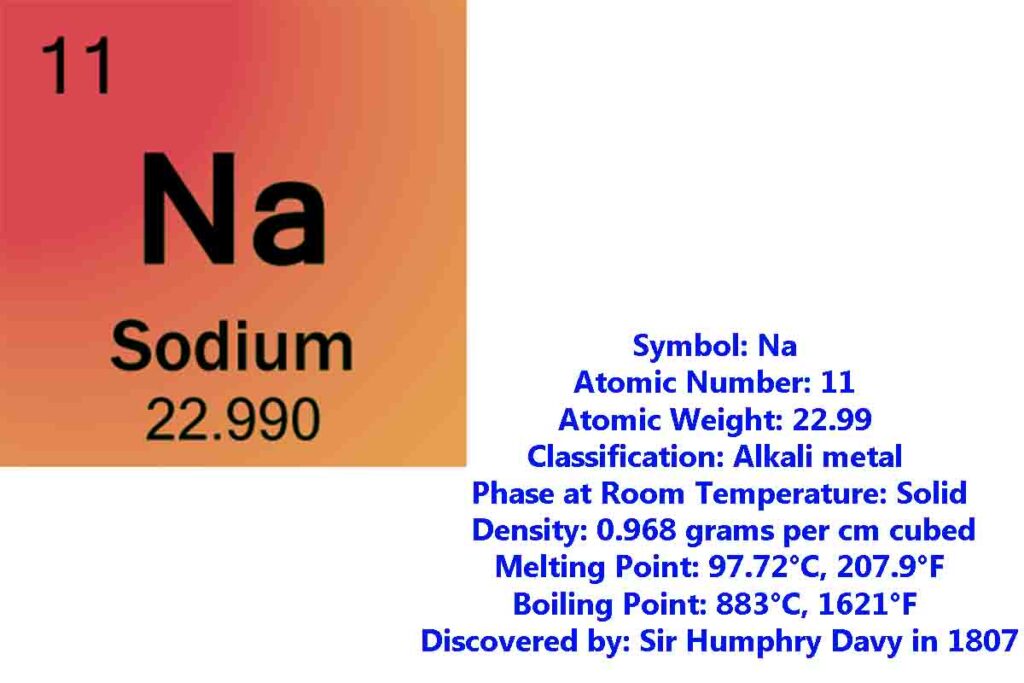Sodium is a metal, located in the first column or group of metals. This sodium atom has 11 electrons and it must have one valence electron outside its outer shell to give energy for bonding with other atoms.

The word sodium comes from the English word soda, and its symbol is Na. This element was first isolated by Sir Humphry Davy in 1807 using caustic soda and the symbol Na was derived from the Latin word Natrium.
Also Read: Mercury element, discovery properties, and uses
Discovery of sodium metal?
Table of Contents
English chemist Sir Humphry Davy is often remembered as the man who discovered sodium. In 1807, he conducted an experiment to isolate this now important chemical by applying electrolysis on caustic soda which resulted in its isolation and identification as a new element – with Davy himself going down into history books for making such an impactful contribution!
Characteristic properties of Sodium metal
Sodium is a reactive metal that can easily be cut with a knife and will burn if you put it in water. It has the ability to float on top of the liquid, but when mixed together they produce an explosion of gas as well! Sodium’s most famous compounds include table salt (NaCl), sodium nitrate(sodium-potassium), and baking soda – all three are found abundantly around us every day without even realizing how many uses there really are for them.
Soda ash also known scientifically as “common lime” may sound like some kind of weird science experiment gone wrong; however, its discovery helped revolutionize modern agricultural practices because before then farmers were using animal bones or other sources containing calcium carbonate which limited crop yields due to too rapid spoilage during storage.
Isotopes of sodium
The most stable isotope of sodium is 23. That’s because only one out of twenty known varieties will maintain its stability, while the others decay over time and become more likely to change back into their original element.
Occurrence of sodium?
It’s the sixth most abundant element on Earth. You’ll never see it in its pure form because of how reactive and volatile it is, but we do have compounds like table salt or NaCl (salt-chlorine) to thank for our ability to get at all that goodness inside us!
The ocean waters are chock full with this mineral – many scientists believe they’re even spilling out more than what goes in due to climate change happening underwater.
Uses of Sodium element
Sodium is a very versatile element and has many uses in both industry and everyday life. Some of the most common uses of sodium metal include:
1. In the production of soaps and detergents. Sodium helps to produce hard water soap and is also used in the manufacture of detergents.
2. As a flux in the metal smelting industry.
3. In the production of glass.
4. In the production of sodium carbonate, which is used in the production of paper, textiles, and other industrial products.
5. As a de-icing agent on roads and pavements.
6. In the production of sodium bicarbonate, which is used in the food and beverage industry.
7. In the production of sodium chloride, which is used in the production of table salt, water softeners, and other industrial products.
8. As a strong reducing agent in the chemical industry.
9. In the production of sodium hydroxide, which is used to make soap; in the process of purifying brine; and in water treatment. Sodium hydroxide is also used to make caustic soda and bleach, as well as other industrial products.
10. As a source of sodium in the laboratory.
FAQs about Sodium
1. What happens when sodium comes into contact with water?
When sodium comes into contact with water it reacts violently to produce sodium hydroxide and hydrogen gas.
2. Is sodium poisonous?
No, sodium is not poisonous. However, it is a reactive element and can cause burns if it comes into contact with the skin.
3. What is the difference between sodium and table salt?
Table salt is a mixture of sodium chloride and other chemicals. Sodium is a pure element, while table salt contains other elements as well.
4. What are some common uses of sodium hydroxide?
Some common uses of sodium hydroxide include making soap, purifying brine, and treating water supplies. It is also used to make caustic soda and bleach, as well as other industrial products.
6. Which chemical process is commonly used to produce sodium metal?
Sodium metal usually forms by reacting hydrogen gas with molten sodium chloride at high temperatures (700-800°C). The reaction produces a bright light that can be seen from miles away due to its intense brightness. Sodium hydroxide gas is produced in this reaction and must be vented carefully because it has a choking effect on the lungs if inhaled.
7. How can sodium be safely handled in the laboratory?
Sodium metal can be safely handled in the laboratory by using a fume hood to exhaust any fumes and by wearing safety goggles and gloves. It is also advisable to avoid skin contact with sodium as it can cause burns. Sodium should never be stored near flammable materials as it is a highly combustible element.
References
1. “Sodium.” Royal Society of Chemistry. http://www.rsc.org/chemistryworld/elements/sodium.asp
2. “Sodium Metal.” Encyclopædia Britannica. http://www.britannica